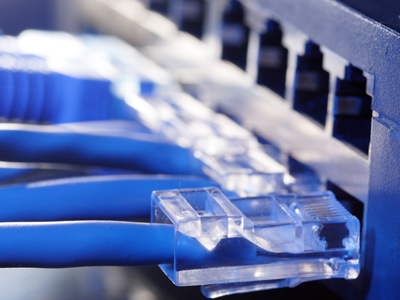Hubs, Switches and Routers: What's the Difference?
Hubs, switches and routers make computer networking, and the Internet, possible. Yet most of us don't know what they are, or how they work.

This article has been updated to provide more information about routers and home networking.

You may often see references to computer-networking devices called routers, switches and hubs. All three connect multiple computing devices such as computers, printers and other networking equipment to one another, but each works differently and for different benefits and purposes.
Hubs
Hubs are the simplest way to connect two or more computers, servers and peripherals to form a simple network. A hub receives signals from each machine though wired connections, and then broadcasts them to all the other connected machines. So if Computer A sends out a signal, Computers B, C and D will all receive it, even if the signal was meant only for Computer D.
Switches
Switches are more complicated in that, unlike hubs, they manage network traffic instead of just broadcasting signals.
Each message sent by a computer or peripheral will contain information about which computer it comes from, and which it's meant for, and the switch makes sure the message gets to the correct destination on the local network. If Computer A sends a message to Computer D, a switch will make sure that Computers B and C don't receive it.
Routers
Routers connect networks of computers, not computers themselves. Unlike switches, which forward messages only to known devices on a local network, routers can forward messages across the world to devices with which they’ve never before communicated.
Imagine a large company that has different computer networks for each department. If Computer A in Accounting wants to send a message to Computer B in Human Resources, the message may pass through a router that's connected to both the Accounting and Human Resources networks.
Get instant access to breaking news, the hottest reviews, great deals and helpful tips.
If there's no direct connection between the Accounting and Human Resources networks, then the router connected to the Accounting network will send the message to a second router, which may in turn send it to a third router, and so on, in order for the message to reach the Human Resources network.
The router connected to the Accounting network knows how to reach the Human Resources network by looking in its routing table, a list of available routes that can be used to reach specific networks.
Because of this intelligent routing, and the need to update and transmit routing information, routers are actually small computers with their own operating systems.
They constantly communicate with other routers, sharing information about traffic routes and network status among themselves, even as they handle network traffic between servers and end-user computers.
Think of a police officer directing traffic at a busy intersection. The cop is telling cars to stop, go, turn left or turn right, which is akin to regular network traffic. But at the same time, the cop is on the radio to other traffic cops, sharing information about which streets are jammed up and which have smoothly moving traffic. Routers do the same thing.
Home networks
The small consumer-based wireless gateway routers used in millions of North American homes and small offices are actually fairly complex devices combining the features of switches, routers and wireless access points.
Acting like switches, wireless routers connect several wired computers, and other wired networked devices such as printers, in the same home or office to form local networks and to manage network traffic. Like routers, they connect the home network to the larger network of the home's Internet service provider (ISP).
Similar to wireless access points, wireless routers send and receive Wi-Fi radio signals from laptops, tablets, smartphones and other wireless devices, and translate the signals into standard wired network protocols before passing them on to the switching functions.
The Internet is a shared connection among of millions of routers, ranging from small home wireless routers to Border Gateway Protocol routers that link giant telecommunication companies. Each router on the Internet is theoretically able to reach any other router, even if the router sending the message isn’t sure whether the destination router exists. But that’s best left for another article.

Tom's Guide upgrades your life by helping you decide what products to buy, finding the best deals and showing you how to get the most out of them and solving problems as they arise. Tom's Guide is here to help you accomplish your goals, find great products without the hassle, get the best deals, discover things others don’t want you to know and save time when problems arise. Visit the About Tom's Guide page for more information and to find out how we test products.
-
spectrewind Really? FAIL ARTICLE. The author is meant to use the work SWITCH instead of HUB.Reply
HUBS CANNOT, by definition, manage layer-2 or layer-3 traffic. They are exclusively a layer-1 (physical) implement. Period. Otherwise it is not a hub.
For you're convenience ::
hxxp: www (dot) thegeekstuff (dot) com/2013/09/hubs-switches-routers/
"These types of network hubs are useful for high-traffic situations, such as a gamer's LAN party, where dozens of players may be connecting to the network"
I love this.
Due to the problems involved in hubs and the LACK of CSMA/CD NIC support as well as MAC2MAC L2 routing that a switch provides, this is why you use a switch, *instead of a hub. Too many collisions and dropped packets! -
burnneck While reading the article and a read that there was an intelligent hub, I facepalmed myself.Reply -
zeducky I honestly fell of my chair while reading this article.Reply
If you know nothing about network equibment, don't write an article! -
spazoid I have never seen an article this bad on the internet before. I struggle to find a single paragraph without factual errors.Reply -
agnickolov Apart from all the misinformation about Ethernet hubs (these did exists in the stone age of networks BTW), there's at least some truth in it since it did mention USB hubs and these are indeed hubs, not switches...Reply -
psyco_kitty I feel like this is a bad April fools joke.... but we're a few months early for thatReply -
pilsner The 10/100 in a switch description does not mean 10 / 100 megabytes per second, it means megaBIT per second. Big difference.Reply -
ro_1984 Appears to be blatantly copied from http://compnetworking.about.com/od/hardwarenetworkgear/l/aa012801a.htm to boot. For shame!Reply -
Vorador2 Good eye ro_1984Reply
I know Toms has lost of lot of quality these last years, but this is pretty embarrassing even for them.
